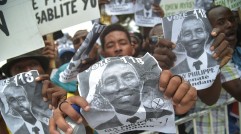Spanish-Speaking, Asian-American, Disabled Medi-Cal Enrollees Less Likely to Access Doctors
Medi-Cal enrollees who are Spanish-speakers, Asian-American, ill and the disabled are most likely to face difficulty when searching for a doctor who will accept them as a patient, according to a recently published study.
The California HealthCare Foundation, an independent agency that looks to inform policymakers and industry leaders, published a report that says although Latinos comprise nearly half of California's 12.5 million Medi-Cal enrollees, 36 percent of the Spanish-speaking Medi-Cal patients have been told that a physician wouldn't take them on as a patient, compared to 7 percent of the overall Medi-Cal population. Even bilingual Medi-Cal enrollees reported difficulty accessing doctors.
Medi-Cal, California's Medicaid program, is public health insurance that offers needed health care services to low-income individuals and families, including families with children, seniors, persons with disabilities, foster care and pregnant women, as well as individuals with tuberculosis, breast cancer or HIV/AIDS. With hotline assistance in 13 spoken and 12 written languages, Medi-Cal was designed to improve the outcomes of communities of color, but disparities have been illuminated.
The state of California welcomed an expansion under the Affordable Care Act, leading to thousands of low-income California residents suddenly becoming insured. Consequently, this also led to delays in patient access to dentists, doctors and specialists; and hospitals and doctors showed an unspoken reluctance to treating Medi-Cal patients because the state paid less than private insurance or Medicaid.
The study, which showed that Spanish-speakers are underserved, does not explain why Latinos (both English- and Spanish-dominant Spanish-speakers) are turned away at high rates, with the Spanish-dominant facing added challenges due to very real language barriers. Policy makers observe that it can be difficult to find doctors willing to take the low payments offered by Medi-Cal, but they've yet to identify race/ethnicity or language as a factor.
Health care agencies in California insist that they're committed to giving Medi-Cal recipients full and equal access to health care. Additionally, the California Medical Association, a representative group for the state's doctors, says its members are sensitive to language and cultural differences. Nonetheless, there is as shortage of providers servicing multicultural communities, as well a shortage of Spanish-speaking providers, which has created a pronounced disconnect.
Latinos and Asian-Americans were most likely to report that they needed language assistance to understand doctors. Approximately 28 percent of Asian-Americans indicated that their doctors didn't properly listen to them, compared to 15 percent of all Medi-Cal enrollees. Furthermore, gaps in access still disproportionately affects those with disabilities and those in poor health, whether patients have Medi-Cal or employer-sponsored insurance (ESI).
"On most measures, access to care Medi-Cal was comparable to Medicaid in other states after controlling for differences in health and socioeconomic status," said the report summary. "Overall, the findings illustrate how factors such as race and place contribute to disparities in access. They also underscore the importance of Medi-Cal in providing access to care and the challenges faced by Medi-Cal and participating health plans to ensure access that is comparable to that of other insured Californians."
The key findings offered in the report include: Medi-Cal enrollees in urban areas faced more cost-related delays in care. Latino and Asian American Medi-Cal enrollees reported greatest difficultly communicating with their physician. Spanish-speakers had the greatest difficulty finding a doctor or specialist that would accept them as a new patient. Medi-Cal enrollees with a limitation were more likely to delay needed medical care due to cost than a Medi-Cal enrollee without a physical limitation. Also, Medi-Cal enrollees already in poor health were less likely to have dental coverage, less likely to see a doctor three or more times in the past year and less likely to get a prescription.
Subscribe to Latin Post!
Sign up for our free newsletter for the Latest coverage!














